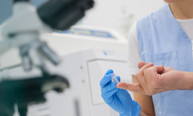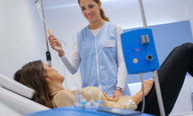What is Lyme disease
Lyme disease is the most frequent infectious multi-system disease transmitted by tick bites by infecting the organism with the bacterium Borrelia burgdorferi. Mosquitoes, fleas, or other insects infected by the bacteria are also transmitters. It is difficult and complex to diagnose Lyme disease because it presents symptoms that often mimic other chronic diseases and requires highly specialized tests that detect the presence of the bacteria in the body.
Chronic Lyme disease, given its complexity and symptomatic variety, requires treatments that adapt to the degree each patient is affected. Nowadays it has sometimes been called Multi-Systemic Infectious Disease Syndrome instead of chronic Lyme. This is the most common tick-borne illness and its incidence is increasing. In fact, the European Commission has already alerted Member States to the exponential increase in this disease and the need for greater medical specialisation, given that patients do not receive the necessary treatment due to the lack of in-depth knowledge of the symptoms and the fact that the usual diagnostic tests are negative in 80% of cases.
At Biosalud Day Hospital, we specialize in the diagnosis and treatment of Lyme disease and follow the guidelines set forth in theILADS guidelines, the international scientific organisation which brings together specialists in the disease.
Symptoms of Lyme disease
The best-known symptom is erythema migrans, but there are very few cases in which this bull’s eye shaped red spot or rash appears or is detected. From the time of the bite, and up to weeks and even years later, a series of symptoms are evident that vary depending on the stage of the disease.
Symptoms of early Lyme are fever, chills, general malaise and headache, joint pain, and muscle stiffness.
We may suspect that we have Lyme if there is weakness or paralysis of the facial muscles, altered heart rate, numbness and pain, difficulty breathing or chest pain.
One of the reasons chronic Lyme is difficult to detect is because it is associated with nonspecific symptoms that appear even years after the disease is contracted. This delay in the time of appearance of symptoms means we fail to connect them to the tick bite. However, when they manifest, the disease has already affected different organs and its consequences may be irreparable: – Musculoskeletal symptoms: chronic inflammation and/or pain in one or more joints, muscle aches or extreme tiredness that prevents patients from walking.
– Neurological symptoms: changes in sensitivity, difficulty in coordinating movements, strange sensations and even psychiatric problems.
– Other symptoms: heart symptoms, short-term memory loss, lack of concentration, swelling of the brain and spinal cord, neuralgia, or stabbing pain in the hands and feet.
Diagnosis of Lyme disease at Biosalud Day Hospital
In Biosalud we have developed specific tests for the detection of the bacteria, avoiding the high numbers of false negatives produced by conventional analyses. In addition, we use the biological medicine approach to specifically understand the patient’s situation at the multi-system level.
Our specific test to detect Lyme disease is the LymeCHECK from Biosalud Analysis. In addition, we perform the following complementary tests:
- Blood level analysis of minerals, vitamins, amino acids, hormones, enzymes, essential fatty acids…
- Check for the functionality of the thyroid and adrenal glands.
- Infrared regulation thermometry, to assess the patient’s physiopathology.
- Biomolecular analysis that indicates the state of the immune system and the molecular alterations that will help us to arrive at the most suitable treatment in each case.
- Canditest® and Koprocheck® for the study of intestinal infections by bacteria, fungi or parasites, as well as deficiencies of intestinal flora, degree of inflammation, permeability, etc…
- Analysis of possible Lyme-accompanying viral infections using Immunocheck® and quantification of all types of defensive cells (lymphocytes) in order to gain an in-depth understanding of the patient’s immune status.
- Nagalase test, quantifying nagalase to assess the level of immune system blocking and Borrelia activity.
- Toxic charges on the patient: ToxicChemicalCHECK® (chemical toxicants), MycotoxinCHECK® (mycotoxins) and HeavymetalsCHECK® (heavy metals in hair, urine and/or faeces).
- Other specific tests required on a case-by-case basis.
Lyme disease treatment at Biosalud Day Hospital
At Biosalud Day Hospital we develop personalized protocols for each patient as the extent of infection and possible associated infections—coinfections—varies greatly from patient to patient. Our Lyme-specific test, Lymecheck® and complementary tests, as well as patient observation and medical history, allow us to make an accurate diagnosis and go further; it allows us to know exactly the level of disease, immunosuppression and chronicity, as well as the therapeutic needs of each case.
As a general outline, our Lyme treatment protocols are developed in several stages:
the therapeutic initiation phase aims to prepare the body prior to Lyme treatment. Since this is a chronic immunosuppressive disease, we must improve the patient’s internal environment according to the results of the tests carried out.
After studying the results in depth, we begin with the treatment according to the following steps:
- Replenishment of nutrients and deficient hormones (essential fatty acids, amino acids, vitamins C, D and B group, minerals (especially zinc), melatonin, DHEAs, etc.)
- Replacement of intestinal flora, treatment of existing bacterial, fungal and parasitic intestinal infections.
- Elimination of chemical toxins, mycotoxins and heavy metals accumulated in tissues that block the immune system.
- Stimulation of the formation of deficient lymphocytes and activation of the immune system.
- Deactivation of previous viral infections that have been reactivated.
- Anything that improves the patient’s situation to be able to start initial intensive treatment for chronic Lyme disease with the highest chances of success.
The techniques used in this phase are: serums with high doses of vitamin C, toxin drainage serums, chelation serums according to the heavy metals to be eliminated, alkalinizing multimineral and vitamin replacement serums, ozone in its different applications (large single or multiphase autohemotherapy or intestinal insufflation), molecular hyperthermia, therapeutic apheresis, neurovegetative injection therapy, micro-immunotherapy, etc.
In this phase the patient follows a home treatment and therapy sessions at our facilities in Madrid or Saragossa once or twice a week, for a period of 2 to 3 months.
In all cases of chronic Lyme, we recommend starting treatment with 2, 3 or 4 weeks of intensive treatment, with intravenous serum with antibiotics, drains and immune system activators. At Biosalud we have developed an innovative system in the application of the antibiotic that eliminates its side effects.
We can also apply some specific protocols with techniques such as ozone therapy (large autohemotherapy and intestinal insufflations), focal magnetotherapy, colon hydrotherapy, oxygen therapy, specific and personalized intravenous serums with high doses of vitamins, minerals and / or amino acids, molecular hyperthermia, body hyperthermia, diathermy, phytotherapy and neurovegetative injection therapy, among others.
In the second week of this intensive treatment, oral antibiotic treatment begins, as indicated by the Lymecheck analysis and the existing co-infections in each case. We always use antibiotics in dosage form with no side effects.
Normally our patients finish this phase in better condition than how they started, often with significant symptomatic improvements, catching a glimpse of the positive possibilities of overcoming the multi-infection and returning to a normal, good-quality life.
Intensive treatment is highly recommended, especially in patients who have been suffering from chronic Lyme for years. However, there may be obstacles, both personal and medical, preventing the completion of this phase. In these cases, we move from the first phase to the third, with treatment at home, although this clearly reduces the chances of therapeutic success.
after these 3 weeks of treatment, a complete treatment is installed at home with antibiotics, immune stimulants, neurotoxin drains, natural anti-infectives, etc. The objectives in this phase are: to improve the compatibility and effectiveness of antibiotics, strengthen the immune system, treat existing pain, change the cellular environment by deacidifying and eliminating excess free radicals to reduce the reproduction of Borrelia, reduce the inflammation maintained by the cytokines and the regulation of the Th1/Th2 and TH17 systems, support the proper functioning of different organs (especially the liver and kidneys), detoxification and improvement of the immune system.
This phase is also accompanied by a weekly, bi-weekly or monthly treatment in our facilities on a case-by-case basis, according to the results of follow-up tests that are carried out every 2-3 months to check the treatment’s evolution and effectiveness.
2 months after the start of the intensive Lyme treatment, we carry out analytical tests to check the patient’s response to the treatment (Lymecheck® and Nagalase® test), to rule out side effects of the treatment, and, after a clinical evaluation review, to propose next steps and how to go about continuing with the treatment.
If the patient has a genetic load (HLA) that prevents a positive response to antibiotic treatment or makes the personal decision to receive only Biological Medicine treatment, we have the necessary protocols in place to apply a treatment with high chances of success.
However, with chronic Lyme, we recommend combining allopathic treatment (conventional, with antibiotics), with that of Biological Medicine because in this way, the possible side effects of the former are reduced to a minimum and its beneficial effects are enhanced. Regardless, everything must be weighed and decided on a case-by-case basis considering the symptoms, the follow-up analyses and the patient’s preferences.
If you want to request an appointment, please, phone us or fill the form and we will get in touch
Everything you need to know about Lyme disease
Lyme Disease symtoms
Lyme Disease Diagnosis
Lyme disease treatment
Early detection of Lyme disease
Diagnosing Lyme disease can be extremely difficult because many of its symptoms are similar to other diseases. It induces immunosuppression and false-negative results from standard blood tests are common. At Biosalud we have the most advanced tests for the specific detection of Lyme disease which, together with an additional round of tests, help us determine the patient’s precise condition and identify any Lyme-associated co-infections.
Early detection of the disease is extremely important; without proper treatment, Lyme can turn into a chronic disease, progressively damaging the body and preventing patients from leading a normal life. Lyme disease can also be highly aggressive, requiring complex, personalized treatment that applies the right treatment for each individual in order to have the best options for getting their health back.
Experts refer to this disease as “the great imitator” because it can mimic many other diseases, including rheumatoid arthritis, multiple sclerosis, fibromyalgia, autism, amyotrophic lateral sclerosis, chronic fatigue syndrome, lupus, ulcerative colitis, and Crohn’s disease.
Lyme disease diagnosis and treatment

Symptoms of Lyme disease
The symptoms of Lyme disease vary in terms of both type and intensity. There are two main groups that can sometimes overlap in the same patient: symptoms that affect the locomotor system (inflammation and/or pain in one or several joints, muscular pains, and fatigue), and those that affect the neurological system (numbness, poor motor coordination, sensitivity to light, and even psychiatric issues).

Erythema migrans in diagnosing Lyme disease
The American ILADS (International Lyme and Associated Diseases Society) states that only 50% of diagnosed patients remember being bitten by a tick. The first sign may be a reddish, target-shaped rash, Erythema migrans, or extreme fatigue. For diagnosis, Biosalud carries out an exclusive analysis, LymeCHECK which allows us to find the bacteria causing the disease and accompanying infections.

Treating Lyme with Biological Medicine
The medical director of Biosalud is accredited by ILADS and is one of the few experts in Spain with this specialized training. The individualized treatment of Lyme is complex due to the immune deficiency and the accumulation of neurotoxins it produces. Many times conventional treatments are combined with antibiotics, with Biological Medicine treatments, such as hyperthermia, molecular hyperthermia, or whole-body hyperthermia.
The expert on Lyme disease answers your questions
If I get bitten by a tick, does it mean that I Lyme disease?
Fortunately, not all ticks are infected by Borrelia burgdorferi, which means that bites do not necessarily mean a positive diagnosis for Lyme disease. However, if you have been bitten by a tick, contact us for a preventive treatment that will prevent chronic Lyme disease from developing.
What symptoms will I have if I’m infected with Lyme disease from a tick bite?
In many cases you will see Erythema migrans, that is, a rash on the skin around the bite in the shape of a bull’s-eye.
You might also have symptoms similar to prolonged flu (muscle aches, stiff neck, headache, etc.), sudden extreme fatigue, and arthritis in one or several joints.
Will I ever get symptoms again if I’m treated for Lyme disease?
If you get treatment immediately after becoming infected it will be very difficult for the disease to progress and you should not develop chronic Lyme disease as a result. If you already have chronic Lyme disease, there may be a recurrence of symptoms when the patient has an immune deficiency, even if all the symptoms have been treated before.
Can Lyme disease be treated without antibiotics?
Each case is unique. At Biosalud we have treatment protocols with antibiotics that we supplement with biological medicine, others where we use only natural anti-infective treatments, and others in which we combine both protocols. It all depends on the specific characteristics of each case, test results, and the patient’s evolution. No two cases are the same and we always offer patients an entirely personalized treatment.
Is Lyme disease deadly?
Lyme patients live with the stress and worry about the symptoms of the disease itself as well as its associated diseases. Lyme disease does not pose a short-term risk to the patient’s life, but it can cause severe damage that makes day-to-day life difficult. Nor can we say that it is a deadly disease, but it is associated with other health issues that can be aggravated by the Borrelia burgdorferi bacterium. As we always say, early detection of the disease, by specialists, is the most effective treatment.

